
We are celebrating 15 years — and counting — of stories that are deeply researched and deeply felt, that build a historical record of what the city has been.
We are celebrating 15 years — and counting — of stories that are deeply researched and deeply felt, that build a historical record of what the city has been.
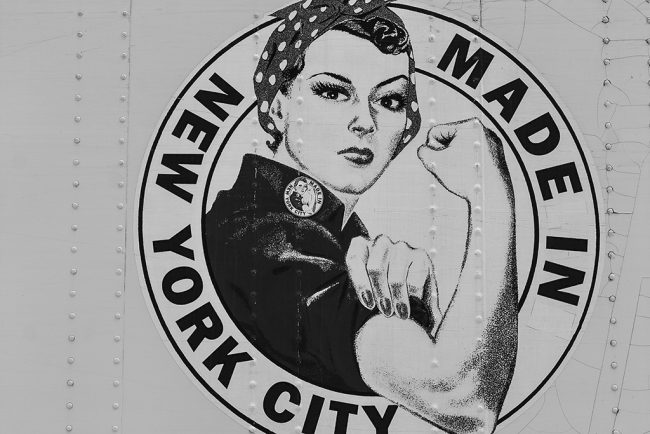
“Made in New York” ad | Photo by Billie Ward
If you ride the subway often, you’ve likely seen “Made in New York” ads showcasing the many movies and TV shows produced across the city. Movies have been made here since the early 1900s, and the industry has weathered many ups and downs since then. The industry faltered between the 1920s and late ‘40s when productions moved to California, but independently produced films spurred a revival in the early 1980s. As the industry declined again in the early 2000s, New York State implemented incentives to stimulate additional film productions. Current legislation provides production companies with a 10 to 30% tax credit to cover production and post-production costs for films made in New York City. The subsidy has fulfilled its intent: by 2013, New York ranked second for the most film jobs by state in the nation, and since 2009 there has been a 43.7% increase in New York City’s film jobs, which now account for two-thirds of the state total.
The incentive’s success is also reflected in the growth of production studios in the city. There are now 36 film production facilities large enough to accommodate films looking to qualify for the tax credits, and multiple are currently looking to expand. Curious about how these studios fit into their neighborhoods and how their future development might alter their surroundings, I embarked on trips to three of the city’s most prominent studios — Steiner, Silvercup, and Kaufman Astoria — and the site of the proposed expansion of York Studio.
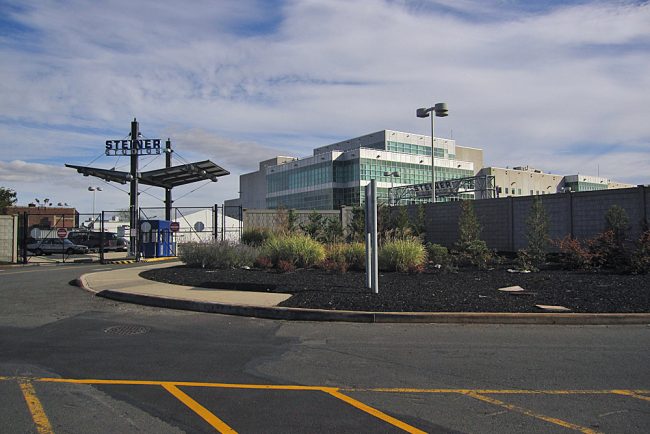
Steiner Studios | Photo by HLIT
Steiner Studio, Brooklyn
Steiner, where the likes of The Wolf of Wall Street, Girls, and Boardwalk Empire have been produced, cannot be considered outside the context of its home: the Brooklyn Navy Yard. Entry to this successful manufacturing center built in the shell of a former naval base is restricted; the main publicly accessible part of the complex is BLDG 92, a visitors center and exhibition space. (That will change with recently announced plans for a public food court in BLDG 77, currently under renovation.)
Steiner is already the largest tenant in the Yard, with its facilities spanning three buildings and ten sound stages. Further expansion is imminent: the studio is developing a media campus of six 16,000-square-foot sound stages as part of a 12-year $347 million master plan to redevelop the currently abandoned Naval Annex Historic Campus on the east side of the Yard. The project, with $6.3 million in public funding from Governor Cuomo and an additional $11.3 million from the NYC Economic Development Corporation, is also part of the Brooklyn Tech Triangle, a large initiative to grow the tech and creative industries in Downtown Brooklyn.
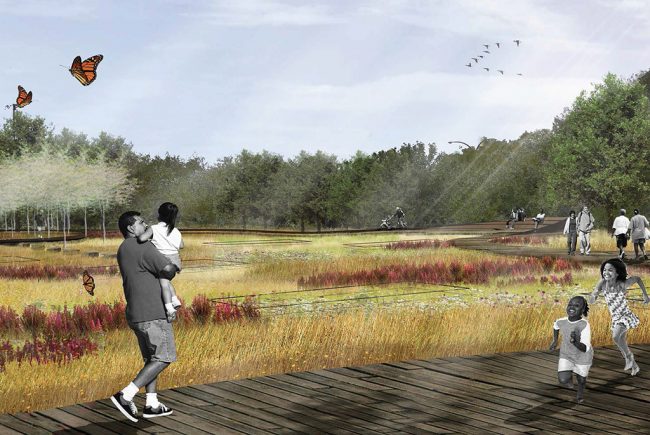
Naval Cemetery Park rendering | Photo via Brooklyn Greenway Initiative
The Yard wraps around Wallabout Bay, and is bordered by Vinegar Hill to the west, Fort Greene and Clinton Hill to the south, Bed-Stuy to the east, and Williamsburg to the north. Between the Navy Yard and the Brooklyn-Queens Expressway sit warehouses dedicated to import/export businesses, auto shops, and gas stations. While the adjacent neighborhoods are mainly residential, the industrial buildings and deserted streets bisected by the highway largely obscured those areas. On the south edge of the Yard, the only signs of life were visitors at BLDG 92 and cyclists along Flushing Avenue. Near the entrance to Steiner on Flushing and Washington Avenue, however, I came upon banks, cafes, and restaurants. Peeking through the fences surrounding Steiner Studio, I saw only parking lots and office buildings of red bricks and glass.
The southeastern corner of the Yard, where the abandoned hospital complex will soon be redeveloped, is currently closed off by vine-covered fences and a high stone wall that marks a significant grade difference between the complex and the street. The future development will be closed to the public along with the rest of the studio, but under the redevelopment plan the Naval Cemetery at the corner of Flushing and Williamsburg Street will become a green space accessible to the public. The park promises to soften the current, hard barrier — plantings and tree rows replacing fences and walls — and will provide a much-needed recreational amenity for South Williamsburg. The media campus will also face outward on the site, rather than sit back from the street like Steiner’s existing facilities. And the studio’s partnerships with Carnegie Mellon University and Brooklyn College will not only provide students with hands-on training but also bring a new population into the Navy Yard. Brooklyn College’s School of Cinema will start classes at Steiner this fall, before the expansion even breaks ground.
Silvercup Studio, Queens
Silvercup is situated in a very different urban context from Steiner’s. The Queensboro Bridge and the elevated 7 line tower over the entire block, which holds the two-story warehouse-like building topped with the studio’s iconic sign. South and east of the studios, block-wide windowless structures with loading docks appeared to be warehouses or light industry spaces. But when I walked by their front entrances, I instead found offices, cafes, a craft brewery, and a CrossFit gym. Following tourists with suitcases in tow led me to a warehouse transformed into a boutique hotel. The warehouse typology obscured what lay inside many of the buildings, but the sign and “Made in New York” banners made Silvercup Studios much more identifiable.
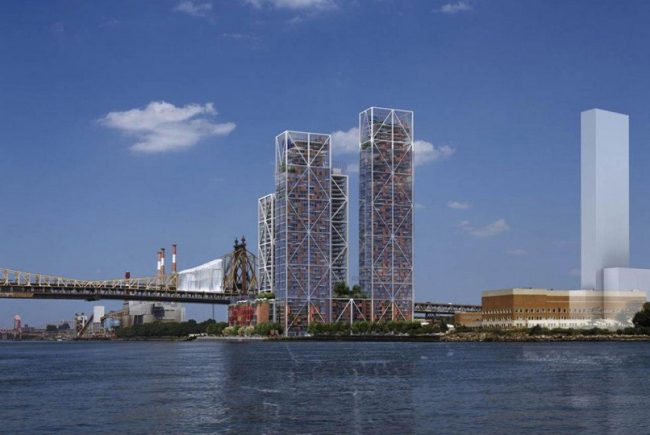
Silvercup West rendering from 2006 | Image by Roger Stirk Harbour + Partners
Last fall, Queens Community Board 2 overwhelmingly approved the special permits necessary to construct Silvercup West, a proposed 2.2 million-square-foot mixed-use complex six blocks west of the current studio, immediately south of the Queensboro Bridge on the East River. Where only the office of a former terracotta factory currently stands, sound stages, an office tower, 1,000 apartments (20% affordable), a parking garage, and retail and cultural spaces would rise. Two 40-floor towers would flank the north and south ends of the site, with studio space and a park in between. The towers in the architectural renderings looked brazen to me before I visited the site, but after experiencing the large building footprints and overpowering infrastructures of the area, the proposed development seemed less out of place. Silvercup West still requires approval from the Department of City Planning to move forward, but other expansions are afoot: on July 6th Silvercup announced that it has bought a 115,000-square-foot warehouse in Port Morris, The Bronx, which it intends to convert into a complex for film and TV production.
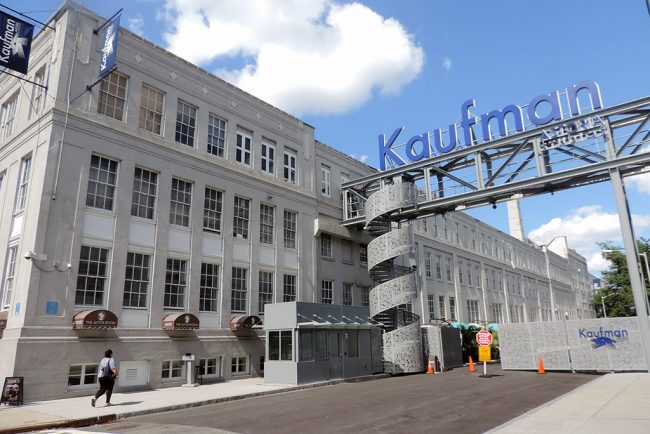
Kaufman Astoria Studio | Photo by Jim Henderson
Kaufman Astoria Studio, Queens
From Long Island City, I proceeded to walk north into Astoria, toward Kaufman Astoria Studio (KAS). Warehouses and deserted sidewalks gradually gave way to row houses on tree-lined streets scattered with hotels and new condo towers. KAS is located in the old Paramount Studio. The historic landmark once housed Paramount Pictures and other independent producers — and fostered the creation of Goodfellas and Hair — before Kaufman purchased it in 1982. Now, banners throughout the neighborhood proudly proclaim KAS as the home of Mad Men. Though the studio complex of sound stages, back lots, and production offices is not accessible to the public outside of special events, KAS presents a particularly welcoming façade. Jazz music trickles out from Astor Room, the restaurant that has served as an ambassador for the studio since the 1920s.
The surrounding environment also differs distinctly from Silvercup and Steiner. Adjacent to the studio stands the Museum of the Moving Image, and across the street sits the Frank Sinatra School of the Arts. Around the complex, chain stores such as Starbucks, Panera Bread, and Ann Taylor Loft occupy storefronts, and people happily lingered and strolled outside when I visited. It reminded me of other historic movie districts, like the Broadway Theater District in Los Angeles and Niles District in San Francisco, that have preserved the historic glamour of their buildings.
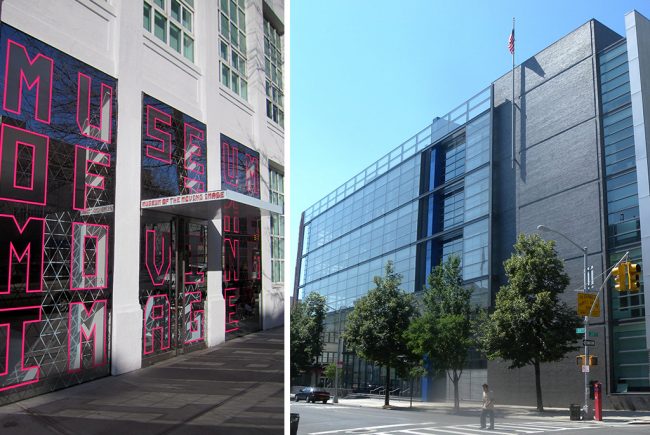
Museum of the Moving Image (L) and the Frank Sinatra School of the Arts (R) | Photo via Wally Gobetz and Jim Henderson
Kaufman’s name recognition also serves as an attractive brand. Surrounding new developments mimic the historic complex’s details and colors to gain visual association. The nearby theater — UA Kaufman Astoria Cinemas 14 — licenses the studio’s name. Last March, the City Council designated the area between 31st Street, 34th Avenue, Steinway Street, and 37th Avenue as the Kaufman Art District. While this is primarily symbolic, being the only artistic district in Queens further enhances the Kaufman brand.
KAS’s past expansions have extended its domain to adjacent blocks bit by bit. The studio constructed New York’s first outdoor film lot by closing 36th Street in 2013. It is currently building an 18,000-square-foot sound stage next to the outdoor lot that is planned for completion in 2016. In addition, KAS has stated several times that it intends to participate in a condominium and luxury hotel development in the neighborhood and is currently building 33 apartments on 35th Street.
York Studio (Proposed), Bronx
York Studio, presently located in Maspeth, Queens, is expanding to a second location on an 11-acre site in the Soundview neighborhood of the Bronx. The site, vacant since defense contractor Loral Electronics shut down in the 1990s, is bordered by the Bruckner Expressway and warehouses to the north, housing complexes to the east, Soundview Park to the south, and the Bronx River to the west. Seeing the effects of film studio development in other neighborhoods, Bronx Borough President Ruben Diaz Jr. hopes the new York facility will stimulate growth in the area.
When I disembarked at the Morrison Avenue station on a recent weekend afternoon, families passed the time at playgrounds in the park and in the sun out front of residential buildings. The site of the new studio was fenced off by high aluminum construction fence, offering only slight glimpses inside. Next door sits the Bronx Arena High School, built in 2004. The Lafayette-Boynton Houses residential complex, across Colgate Avenue from the future studio, consists of four tall towers with large swaths of green in between. The nearby expressway proved much less overpowering than the BQE or Queensboro Bridge, and the river and the park provide a wide vista. The proposed plan calls for four buildings: the largest along the Bronx River, two fronting Colgate Avenue, and a smaller building with adjacent parking lot facing Story Avenue. The complex will include eight studios once complete. The company hopes to have at least one up and running by summer 2016.
Gloria Lau is a landscape architect and urban planner practicing in New York City. She also writes about related topics for Projexity’s Site&Seek series. Follow her at @gloriakwlau.
The views expressed here are those of the authors only and do not reflect the position of The Architectural League of New York.